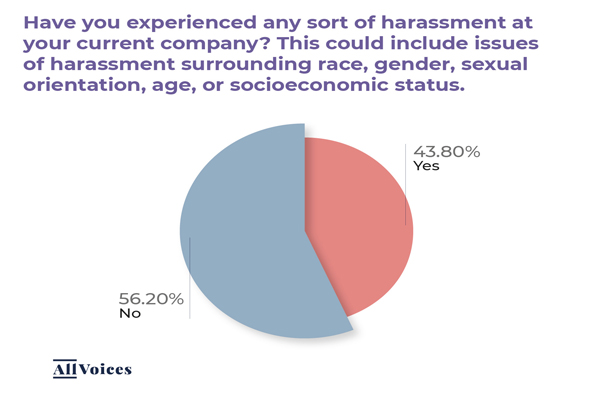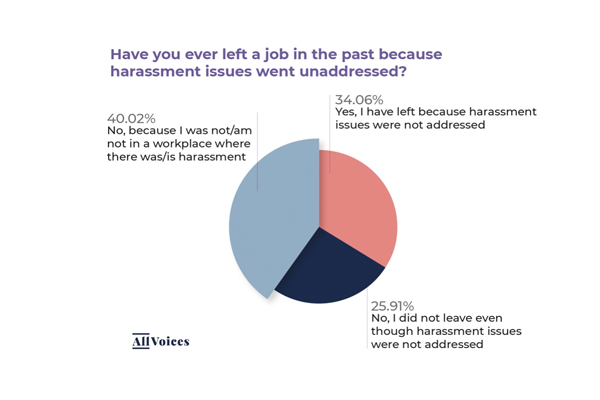Over a third (38%) of US workers said they still experienced harassment remotely, through email, video conferencing, chat apps, or by phone, this year, according to a new study.
In fact, around a quarter (24%) believe actually harassment continued or got worse through remote work channels, revealed the State of Workplace Harassment 2021 report from AllVoices, the employee feedback management platform. No wonder over half employees (52%) have not felt psychologically safe at work.
“High-profile issues of harassment in workplaces seem to be hitting the news every week, but issues like workplace harassment happen at all levels and in all industries,” stated Claire Schmidt, CEO and Founder of AllVoices. “This report reveals that even in a work from home or hybrid environment, harassment doesn’t disappear.”
The report surveyed employed Americans (full time) to better understand their experiences, frustrations and suggestions for organisations to handle workplace harassment. Employees from across all sectors and job levels participated to share their experiences with harassment, why many of them are reluctant to report, and what practical approaches workplaces can take to combat harassment today.

HARASSMENT AT WORK
Overall 44% have experienced harassment at work; mostly experienced personal harassment (48.6%), followed by discriminatory harassment (43.3%) and online harassment (40.6%). Other types of harassment includes:
- Physical harassment (39.4%)
- Sexual harassment (37.8%)
- Psychological harassment/misuse of power (36.7%)
- Abuse of power (35%)
- Gender-based harassment (34.4%)
- Racism (30%)
- Microaggressions (29.2%)
- Socioeconomic harassment (26.1%)
- Other (5.8%)
COMMON FORMS OF HARASSMENT
The type of harassment also varied depending on sex, race and age. For example, female respondents had experienced more sexual harassment (38.8%) and discriminatory harassment/bias (36.4%). Male respondents had experienced personal harassment/in-person bullying (55.8%) and physical harassment (51.1%) more. Black respondents had mostly experienced personal harassment/in-person bullying (38.9%) and racism (36.1%) more.
Asian respondents mostly experienced discriminatory harassment/bias (42.9%) and psychological harassment/misuse of power (42.9%). Entry-level respondents experienced more physical harassment and discriminatory harassment/bias (both at 55.8%). And those over the age of 45 experienced personal harassment/in-person bullying (48%) and discriminatory harassment/bias and psychological harassment/misuse of power (both at 38%) more.
The report also found that harassment comes from both managers and co-workers. Around 38.2% of employees witness harassment from managers against employees; and 36.8% have seen harassment happen between co-workers. Additionally, 25% have witnessed both harassment from both managers and between co-workers.

DAMAGING IMPACT OF HARASSMENT
The report concluded that harassment is pervasive, and damaging to morale, productivity, workplace culture, and employees’ futures. Yet not only is harassment “allowed to go on”, sometimes “whole cultures are built around accepting it; or ignoring it when it happens”. In fact, the report revealed that 34% have left a job because of unresolved harassment issues. However, 26% have remained at a workplace despite there being ongoing issues of harassment.
Yet, only 50% have reported harassment. Additionally, 18% said that even though they experienced or witnessed harassment, they did not report it for fear of retaliation, that nothing would be done about it, or that they wouldn’t be believed.

That said, 85% are more likely to report harassment if they have an anonymous channel. Additionally, respondents believe that they and their co-workers would be more encouraged to report with an anonymous reporting tool or platform. Interestingly just 72% of staff believe their workplace wants harassment reported; and 28% say their workplace does not encourage employees to raise issues of harassment. Just 53% say their workplace immediately addresses harassment. However, 12% have not seen any action from their workplace; and 14.7% said they aren’t aware of any action taken. Additionally, only 54% of respondents have had their issues fully resolved.
WORKPLACE SOLUTIONS
There’s still a lot of work to be done, notes the report. One of the first steps is not just listening to — and believing — employees, but also valuing your organisation’s health and wellbeing enough to want to hear about issues of harassment. Schmidt believes that organisations need to implement options for employees to share feedback in a way that makes them feel safe and heard. “When more concerns are being voiced, companies can work proactively to uncover and address workplace issues,” she added.
To download a full copy of the report, click here.
A recent report also revealed the true financial costs of workplace sexual harassment for women. Click here to read more.







































